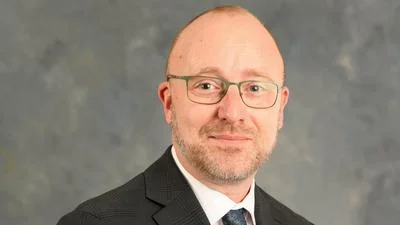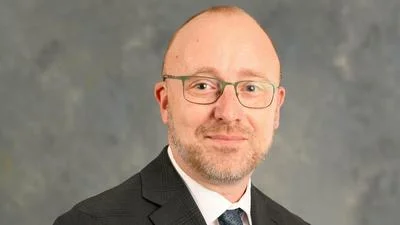Village of Oswego Committee of the Whole met Oct. 16.
Here is the minutes provided by the committee:
CALL TO ORDER
President Gail E. Johnson called the meeting to order at 6:01 p.m.
ROLL CALL
Physically Present: President Gail Johnson and Trustees Ryan Kauffman, Karin McCarthy-Lange, Pam Parr, Luis Perez, Judy Sollinger and Joe West.
Staff Present: Tina Touchette, Village Clerk; Jeff Burgner, Police Chief; Jennifer Hughes, Public Works Director; Mark Horton, Finance Director; Rod Zenner, Community Development Director; Corinna Cole, Economic Development Director; Jay Hoover, Building & Zoning Manager; Jenette Sturges, Community Engagement Coordinator- Marketing; Steve Raasch, Facilities Manager; Natalie Zine, Planner; Billie Robinson, Asst. Finance Director; and Dave Silverman, Village Attorney.
CONSIDERATION OF AND POSSIBLE ACTIONS ON ANY REQUESTS FOR ELECTRONIC PARTICIPATION IN MEETING
There was no one who participated electronically.
PUBLIC FORUM
Public Forum was opened at 6:01 p.m.
There was no one who requested to speak; the Public Forum was closed at 6:01 p.m.
OLD BUSINESS
There was no Old Business.
NEW BUSINESS
F.1. Sikich LLP Fiscal Year 2017 Financial Audit Presentation
Director Horton addressed the Board regarding the presentation of the Comprehensive Annual Financial Report (CAFR) for fiscal year ending April 30, 2018. The final audit report was presented by Brian LeFevre from the auditing firm of Sikich, LLP. For the 15th consecutive year, the Village has received the Certificate of Achievement for Excellence in Financial Reporting. Mr. LeFevre provided an “unmodified opinion” and briefly addressed the following:
• Introductory Section
• Independent Auditor’s Report
• Other Reporting Required by Government Auditing Standards
➢ New requirements
➢ Separate compliance
➢ Opinion on pages 118-119
• Management’s Discussion and Analysis ➢ These are the “whys” of the statement ➢ Required document by GASB
• Statement of Net Position
➢ New requirements next year
• Statement of Activities
• Balance Sheet; Governmental Funds
• Statement of Revenues, Expenditures and Changes in the Fund Balances; Governmental Funds
• Statement of Revenues, Expenses and Changes in Net Position; Proprietary Funds
• Statement of Changes in Fiduciary Net Position; Pension Trust Fund
• Schedule of Employer Contributions; IMRF (last three fiscal years)
• Schedule of Employer Contributions; Police Pension Fund (last ten fiscal years)
• Schedule of Changes in the Employer’s Net Pension Liability and Related Ratios; IMRF (last three calendar years)
• Schedule of Changes in the Employer’s Net Pension Liability and Related Ratios; Police Pension Fund (last four fiscal years)
• Schedule of Investment Returns; Police Pension Fund (last four fiscal years)
Mr. LeFevre did not go over the Statistical Section. The audit went smoothly. Staff was very professional, prepared and easy to work with.
Board, staff and Sikich discussion focused on expected pension; not wanting a repeat of 2016; every year there are new actuary tables; people are living longer; 65% is considered reasonably funded; plenty of funds to make payments; Village is doing exactly what they are supposed to do; market value; Illinois Department of Insurance gathers information; IMRF is a more highly funded plan; no requirement, in the past, to fund some pensions; some are funding only at 30%.
Mr. LeFevre also discussed the actuary; reliable financial advice, GASB 75 Statement; other standards relating to leases in the future. Director Horton noted Assistant Finance Director, Billie Robinson, created the cover of the report. There was no further discussion.
F.2. Review the Police Pension Fund Actuarial Report Dated August 17, 2018
Director Horton addressed the Board regarding the Police Pension Fund Actuarial Report Dated August 17, 2018. Director Horton briefly addressed the following:
• Summary of Results
• Tax Levy Requirement
• Summary of Plan Participants
• Projected Pension Payments
• GASB Statements
Additional information provided included filing in December; mortality tables updated; payroll growth assumptions; amortized payments; contribution amount may need to be increased. There was no further discussion.
F.3. Discuss the Calendar Year 2018 Village Tax Levy with the Village Board
Director Horton presented options to the Board concerning the 2018 tax levy. Each year, staff discusses increasing, decreasing, or maintaining the property tax levy rate with the Village Board prior to preparing the ordinances for Village Board approval. Staff provided two options for consideration in preparation of the 2018 Village of Oswego property tax levy based on an estimated 6% EAV increase provided by the Kendall County Supervisor of Assessments:
• Maintain the property tax levy at the same tax rate as the 2017 tax levy; $0.1539 per $100 of equalized assessed valuation
➢ Keeps the tax rate the same at $0.1539 per $100 of EAV
➢ Will increase the tax levy by $80,434; providing additional funding for increases in operating costs and increased pension costs
• Keep the tax levy at the same dollar amount as the 2017 tax levy; $1,343,397
➢ Levy the same dollar amount as 2017
➢ Will keep the levy at $1,343,397 and lower the tax rate to an estimated 0.1452; a decrease of 0.0087
The calendar year 2018 tax levy assists in financing the fiscal year 2020 expenditures. Estimated annual revenue for fiscal year 2020 may not be enough to support the increased operating costs and annual increases in contributions to the pension funds. For example, the Police Pension contribution will increase a minimum of $82,046 (total required contribution of $1,398,759) and the IMRF contribution is estimated to increase $26,184 (total contribution of $454,660). Maintaining the tax levy rate equivalent to the 2017 tax rate will generate an estimated additional $80,434 in property tax revenue. This will help offset a portion of the pension cost increases and allow other revenues to support increased operating costs. Both tax levy options abate all the debt service tax levies. The total debt service abatement for 2018 is $4,243,075. This is $19,050 less than last year’s total abatements. Water revenues, motor fuel tax revenues and general operating revenues pay the total abated debt service. Staff recommended preparing the 2018 calendar tax levy with the tax rate equal to the 2017 calendar year tax levy.
Board and staff discussion focused on home values have gone up this year; recommend doubling or tripling the tax rate;.1539 for next three years; $82,046 is the total increase of both pensions; thought the Village was going to make small changes last year; last year it was discussed to levy enough to cover the pensions and keep the tax rate the same; if choosing option two, would need to take $82,046 from the general fund each year; creating a third hybrid option; appreciate the sensitivity; homeowners will see an increase from the school district; decrease the rate due to a high EAV; increasing only half; concerns with taxes going up because the schools are increasing another 1%; whether we want to lose Police services, water safety, road maintenance; $7 annual increase is fair; money has to come from somewhere; property taxes are not fully covering the pensions; $1.3 million is very small compared to others; gas and sales taxes go to capital improvements, road improvements and the Police Department; Village needs $3-4 million in new revenue each year to make ends meet; operating costs are increasing every year; staff was given direction to only ask for what they need to operate; information to be provided to the Board; asked whether the Board wants to capture new growth; levying the same dollar amount spreads it across more people; all new growth lowers the amount and gives the Village less; option two is irresponsible; what the Village has done has spurred growth; five Trustees were in favor of moving forward with option one. There was no further discussion.
F.4. Fiscal Year 2020 Village Budget Discussion to Solicit Village Board Directives
Director Horton addressed the Board regarding the Fiscal Year 2020 Board Directives. Annually, the Village Board is requested to provide ideas they may have, or specific requests they wish to have included in the budget preparation process. The Board was directed to provide ideas to the Village Administrator or Department Heads. Meetings with Department Heads, on budget requests, is scheduled for December 10-18, 2018. Budget workshop is scheduled for March 2, 2019.
F.5. Discuss Status of Bringing Metra Commuter Rail Service to Kendall County.
Director Hughes addressed the Board regarding the status of Metra. Since the late 1990’s, Kendall County communities have worked to bring Metra commuter rail service to Kendall County. A presentation was provided that outlined the history of the project, current status and next steps:
Metra Service to Kendall County
• Project Understanding
➢ Kendall County BNSF extension approximately 19 miles
➢ Project Benefit
✓ Kendall County has experienced tremendous growth over the past two decades
✓ Current unmet demand for Metra service
✓ Metra service would provide an economic boost to the region and draw new employers ✓ Metra service would unlock Kendall County’s connection to the rest of the Metro area ✓ Mass transit is a more environmentally sustainable form of transportation
• Project History
➢ July 6, 2000- Kendall County issues RFP for a feasibility study
➢ June 18, 2011- Phase 1 is completed; concluding that extending the BNSF line to Kendall County is feasible
➢ July 5, 2002- Phase 2 is completed, but only studied stations in Montgomery and Oswego
✓ 10 one-way trips envisioned on weekdays only (5 in each direction)
✓ Four trainsets required to be stored in a new small yard
✓ Capital estimates for a 6-mile extension equal $95.6 million
✓ Annual operations/maintenance estimated at $6.7 million
✓ 2020 ridership projection of 4,580 daily boardings (2,290 riders)
✓ Next steps- further studies on financial feasibility, funding availability, railroad discussion, formalization of local support
➢ 2004- Oswego acquires future station site west of Orchard Road and opens Park N’ Ride facility
➢ 2003-2007- $7.5 million in federal earmarks secured to further study the extension
➢ 2010- CMAP approves Go To 2040 Plan which includes extending BNSF service to Oswego as a fiscally un-constrained project (lower priority)
➢ February 17, 2012- Metra approves preliminary engineering and environmental assessment contracts for $1.75 million
➢ 2013-2015- Metra approves $1.09 million in change orders, adding Yorkville yard and station sites to the studies
➢ August 26, 2015- Metra Board suspends the studies to devote their resources on existing needs rather than expanding service
➢ 2016- Oswego acquires 15-acre site north of the tracks for future station parking
➢ May 18, 2016- Metra Board authorizes the restart of the studies after receiving letters of support from federal, state and local officials
✓ Study includes Montgomery, Oswego, Yorkville and Sandwich
➢ 2017-Oswgeo approves new strategic plan that includes bringing Metra service to Kendall County as a priority project
➢ 2018- Metra finally receives BNSF authorization to proceed with the studies
✓ Metra decides after six years to cancel the 2012 studies and rebid the contracts
✓ New preliminary engineering and environmental contracts expected to be executed by the end of 2018
✓ Studies are expected to be completed by the end of 2019
✓ RFP is currently on the Metra website
• Latest News
➢ CMAP OnTo2050 Plan
✓ Goal- become a fiscally constrained project (high priority)
▪ Eligible to receive federal transportation funds
▪ Major capital projects are large and have a significant effect on the capacity of the region’s transportation system
o Must have a detailed transportation financial plan
o Lower in priority then existing system improvements
✓ Was approved on 10/10/18
▪ BNSF extension is included
▪ Can be updated after adoption
▪ BNSF study could be considered once the studies are complete and costs are known
✓ Oswego engaged in a public information campaign to encourage public comment on the draft
▪ Oswego, Yorkville and Plano approved resolutions in support of the project
▪ Hundreds of residents commented; resulting in CMAP adding language to the plan showing the significant public support for the project
➢ Funding
✓ Key component will be financing and preliminary strategy
✓ Capital dollars
▪ Impacted communities will need to identify funding sources
▪ Depending on where the last stop will be, estimates range from $150-$300 million
✓ Operating dollars
▪ Studies will identify operating costs and verify each station will be financially sustainable
➢ Funding Strategy
✓ Federal transit administration capital investment grant programs
▪ $2.3 billion available each year through 2020
▪ New starts program for projects $100+ million
▪ Past projects have a minimum 50% local share ($75-$100 million)
✓ Local share options
▪ State capital bill
▪ Bonding local sales tax
➢ State Capital Bill
✓ Last major State capital bill was $31 billion back in 2009
▪ Major funding source was video gaming
✓ Both gubernatorial platforms include a plan for a capital bill in 2019
▪ Possible funding sources include legalizing cannabis, legalizing sports betting and creating a mileage tax
✓ The 2019 legislative session may be the only opportunity in the next decade to leverage State funds
➢ State Legislative Support
✓ Project must be a priority for Oswego and Kendall County communities
✓ Key to securing capital dollars will be strong and continued support from our eight State legislators
✓ Staff has been speaking with lobbying firms
▪ Lobbyists help with strategy and provide a presence in Springfield
▪ Firms cost between $5,000-$10,000 per month
▪ Other communities may also be interested in sharing the cost of a lobbyist
➢ Joining the RTA (Regional Transportation Authority)
✓ RTA oversees Metra, Pace and the CTA
✓ Kendall County is not currently a member of the RTA
▪ Members include Cook, DuPage, Kane, Lake, McHenry and Will
✓ RTA sales tax is the primary source of revenue for the RTA system
▪ 1.25% sales tax in Cook County and 0.75% sales tax in collar counties
▪ In the collar counties, 0.50% sales tax goes to the RTA; 0.25% goes to the counties for transportation and public safety ✓ Ways to enter into the RTA
▪ Extra territorial authority
▪ Annexation • Next Steps
➢ Long and complex process; results are not guaranteed
➢ Actively lobby for funding; results are not guaranteed
➢ Significant staff /Board time and effort over the next six months and beyond; results are not guaranteed
➢ Now is the time to decide the level of support for the project
Board and staff discussion focused on dual tracks; third line; connecting to the city; environmental benefits; workforce percentage; how to pay for; 50% match required; costs; revenue generated; Metra out to bid for a new study; 2000 study stopped the train before Oswego; needing to complete the next phase of engineering; CMAP received 700 comments from people in the County; concerns with Metra being able to fund their services currently; burden locally is greater; positioning for the opportunity; getting in the door with the correct people; not currently members of the RTA; can’t move forward without being in the RTA; long project; interviews with lobbyists; sales tax portion; how many people ride the train; Park & Ride usage; service provides economic development; younger generation trending towards not driving and wanting mass transit; commuter rail versus passenger; not wanting to commute in a car; Elburn has a station and train service; citizens would vote on the RTA tax; Village needs to find funds; have five months to get the federal funds; people frustrated with the project not moving forward; people will drive to the Park & Ride to board a train; parking at Aurora and Eola is at a premium. Item will be brought back to the November Board meeting. There was no further discussion.
CLOSED SESSION
There was no Closed Session held.
ADJOURNMENT
The Committee of the Whole meeting adjourned at 7:13 p.m.
http://www.oswegoil.org/pdf/10-16-18-cotw.pdf






 Alerts Sign-up
Alerts Sign-up